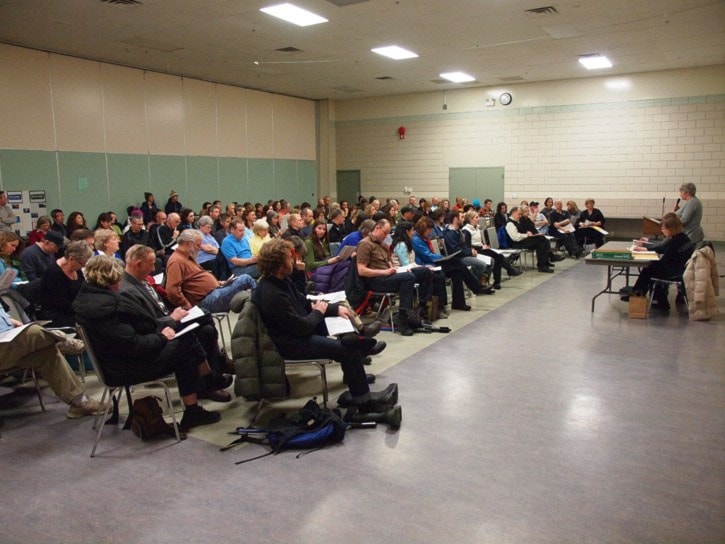Should more stable funding be available for groups that get approved each year?
There are 39 projects vying for funding from the Columbia Basin Trusts’s Community Initiatives & Affected Areas program this year. Last Monday, the public presentation part of the application process was held and one-by-one, each group went up to make the case for funding.
There was Patti Larson from the food bank, looking for $30,000 – nearly 20 per cent of the program’s budget for the year. Troy Leahey of Canadian Canine Seach & Rescue was seeking $27,500 in funding to help train rescue dogs and their handlers, and purchase equipment.
Cathy Girling asked for funding for the Community Connections’ social justice advocate position. The Revelstoke Cycling Association asked for money for new trails and improved infrastructure at Mt. Macpherson and Boulder; the squash club wanted money for a ball feeder to help people practice. The North Columbia Environmental Society put in two requests – one to support its regular programs and the other was a willow planting project at Martha Creek. The city’s museums each made their case for funding to help them deliver their programs, while the Revelstoke Arts Council put in a request for $25,000 to support its cultural programs.
In total, community groups are seeking a total of $531,806 in funding from the program. That money would help fund $1,135,701 in projects. The funding available this year is $351.538.
There were many more similar requests by cultural, environmental, social and sports groups.
The next day I was at another meeting and we started talking about the CBT meeting. Someone brought up the length of the meeting, which led someone else to wonder why there are so many groups that go up for funding for the same projects every year.
That piqued my curiosity so I did some digging. Looking through the past three years, I counted 14 groups that have received funding for pretty much the exact same project every year. Another 10 received regular funding, though the projects differed from year-to-year.
Should there be more stable funding available to groups that have proven themselves over the years? I called up Loni Parker, the Revelstoke area director about that.
“When the CBT set this program up, they didn’t want it to be core funding for community groups,” she told me. “They wanted community groups to come forward with projects that fit the criteria. Not for core funding that keep their groups moving forward with their program.”
It appears that isn’t the case. The food bank has received $45,000 over the past two years to support its programs. Other Community Connections programs like the social justice advocate and summer day camp also received core funding from CBT to operate. Bear Aware gets almost half of its funding from the trust, while the Community Response Network, which is run by the Revelstoke Women’s Shelter, also gets a big chunk of its annual funding from the CBT.
Funding decisions in Revelstoke are made by a committee but the community also get a say in who gets a slice of the pie. At the end of last week’s meeting, everyone was asked to list their top 10 projects – that ranking counts for 15 per cent of the final score. I asked Parker why groups that have been chosen for funding every year don’t have access for something more stable? Having to go back for money every year creates instability and makes planning difficult.
“It would give huge security to community groups to know they have secure funding that was guaranteed for more than one year,” said Jackie Pendergast, the director of the Revelstoke Visual Arts Society.
I posed a similar question to Cathy Girling at Community Connections but she declined to comment at a time when the organization was looking for funding.
Parker touted the benefits of the process. Each year, she said, the community gets to hear about the different things going on and they get a say in what gets funded.
“It’s great information for the community to have,” she said. “Two, it solidifies the level of support from the public for these particular projects. Three, I think it’s a great way to go.”
The program was set up to fund projects identified as priorities in communities in the basin. It wasn’t set up to provide core funding, but, according to Parker, if a community continually votes to support, for example, Bear Aware, then they should get funding.
“This process shows us what programs the community values,” she said.
She added that no group had ever approached her about this issue, though Lynda Lafleur, the Community Liaison for CBT said she had heard some grumbling about the process.
“Ultimately we allow our government partners to develop their process and I believe they will adjust the process based on community feedback,” she said, adding it is up to the committee that makes the funding decisions to look at the process based on what they hear.
“We trust they’ll make that call with the best interest of their community,” she said.
Correction: An earlier version of this article stated that the Revelstoke Women's Shelter got a big portion of its funding from the Columbia Basin Trust. In fact, it is the Community Response Network, which is run by the Revelstoke Women's Shelter Society that gets a large portion of its funding from the CBT. The women's shelter funding comes from BC Housing.
